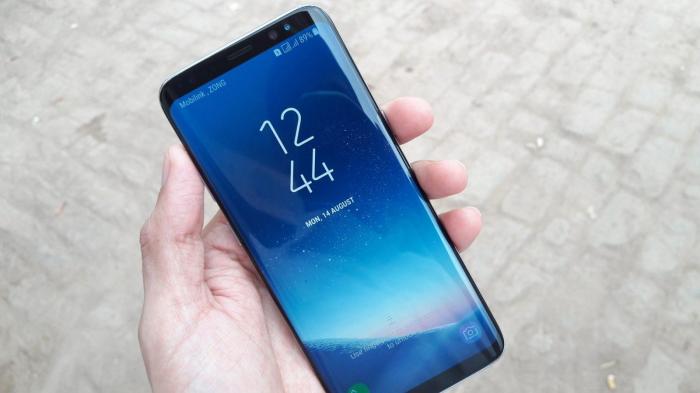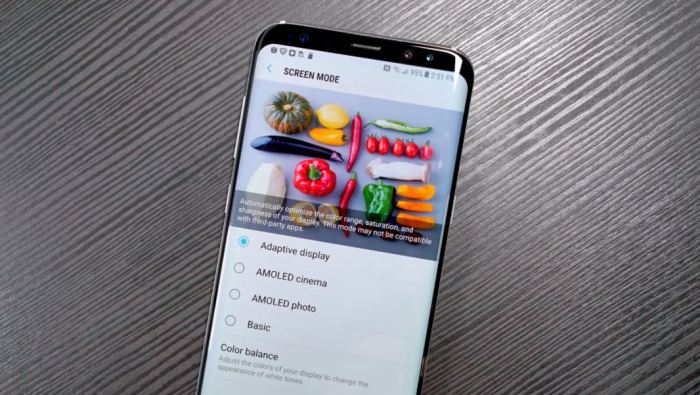The Galaxy S8
The Galaxy S8 was a significant milestone for Samsung, marking a departure from the design language of its predecessors and ushering in a new era of innovation for the company. It was released in 2017, following the Note 7 debacle, and was Samsung’s attempt to regain consumer trust and establish itself as a leader in the smartphone market once again.
Key Features and Specifications
The Galaxy S8 was packed with impressive features and specifications, making it one of the most advanced smartphones of its time.
- Display: The Galaxy S8 boasted a stunning 5.8-inch Super AMOLED display with a resolution of 1440 x 2960 pixels. The display was curved on both sides, providing an immersive viewing experience.
- Processor: It was powered by either the Qualcomm Snapdragon 835 or Samsung Exynos 8895 processor, depending on the region. These processors were some of the most powerful available at the time, delivering exceptional performance.
- Camera: The Galaxy S8 featured a 12MP rear camera with an aperture of f/1.7, capable of capturing high-quality images and videos even in low-light conditions. It also included an 8MP front-facing camera for selfies and video calls.
- Battery: The Galaxy S8 was equipped with a 3,000mAh battery, which provided decent battery life for a device with such a powerful processor and display.
- Software: The Galaxy S8 shipped with Android 7.0 Nougat, with Samsung’s own custom user interface, Samsung Experience, layered on top. It offered a variety of features and customization options.
- Storage: The Galaxy S8 came in 64GB and 128GB storage options, with the ability to expand storage further using a microSD card.
- Other Features: The Galaxy S8 included features like iris scanning, facial recognition, water and dust resistance (IP68 rating), and a dedicated Bixby button.
Design
The Galaxy S8’s design was a major departure from its predecessors. The phone featured a sleek, curved design with a near bezel-less display, known as the “Infinity Display.” The curved edges of the display extended almost to the edges of the phone, providing a truly immersive viewing experience. The phone also featured a glass back, giving it a premium look and feel. The overall design was sleek and modern, showcasing Samsung’s commitment to pushing the boundaries of smartphone design.
The Curved Display Trend
The rise of curved displays in smartphones has been a significant development in the mobile industry. Curved displays, also known as edge displays, offer a unique and immersive viewing experience that has become increasingly popular among smartphone users. This trend has been driven by advancements in display technology and the desire for a more aesthetically pleasing and functional design.
Benefits of Curved Displays
Curved displays offer a number of benefits, including:
- Enhanced Viewing Experience: Curved displays create a more immersive viewing experience by wrapping around the edges of the phone, reducing distractions from the surrounding environment. This can be particularly beneficial for watching movies, playing games, and browsing the web.
- Improved Grip: The curved edges of the display can provide a better grip on the phone, making it less likely to slip out of your hand. This can be especially useful for people with smaller hands.
- Larger Screen Real Estate: Curved displays allow manufacturers to fit larger screens into a smaller form factor. This means that users can enjoy a larger screen without having to carry a bigger phone.
- Aesthetically Pleasing Design: Curved displays add a premium and modern look to smartphones, making them more visually appealing. They can also be used to create unique and innovative design features.
Drawbacks of Curved Displays
While curved displays offer several benefits, they also have some drawbacks:
- Accidental Touches: The curved edges of the display can be more susceptible to accidental touches, especially when using the phone with one hand. This can lead to unwanted actions and interruptions.
- Increased Cost: Curved displays are more expensive to manufacture than flat displays, which can lead to higher prices for smartphones with curved screens.
- Repair Costs: Replacing a cracked or damaged curved display can be significantly more expensive than replacing a flat display. This is because the curved glass is more complex and difficult to manufacture.
- Limited Screen Protection: The curved edges of the display can be more vulnerable to scratches and damage, as they are not as well protected as the flat areas of the screen.
Comparison of Curved and Flat Displays, Galaxy s8 no flat screen variant
The user experience of a curved display compared to a flat display is a matter of personal preference. Some users prefer the immersive viewing experience and enhanced grip that curved displays offer, while others find them prone to accidental touches and more expensive. Ultimately, the best type of display for you depends on your individual needs and priorities.
Reasons for No Flat Screen Variant
The absence of a flat screen variant for the Galaxy S8 sparked curiosity among tech enthusiasts and consumers alike. While Samsung had previously offered both flat and curved screen options in its flagship devices, the S8 marked a shift, opting exclusively for a curved display. This decision, driven by a confluence of factors, aimed to enhance the user experience and align with Samsung’s design philosophy.
Market Demand for Flat Screen Smartphones
The market demand for flat screen smartphones at the time of the Galaxy S8’s release was substantial, with numerous competitors offering flat screen options. However, Samsung’s research indicated a growing preference for curved displays, particularly among users seeking a premium and immersive experience.
“The curved display is the future of smartphones,” said a Samsung executive at the time. “It offers a more immersive experience, and it’s also more aesthetically pleasing.”
Samsung’s decision to focus solely on curved displays was based on its belief that this design element would become increasingly popular among consumers. The company’s market research and analysis suggested that curved screens provided a competitive edge in terms of design, functionality, and user experience.
Samsung’s Design Philosophy and Focus on Innovation
Samsung has a long history of pushing the boundaries of smartphone design and technology. The company’s design philosophy centers around innovation, user experience, and aesthetic appeal. The Galaxy S8’s curved display was a testament to this philosophy, reflecting Samsung’s commitment to creating devices that are both functional and visually stunning.
“We are always looking for ways to innovate and improve the user experience,” said a Samsung spokesperson. “The curved display is a perfect example of how we are pushing the boundaries of what is possible with smartphones.”
The curved display offered a number of advantages over flat screens, including a more immersive viewing experience, a wider field of view, and a more comfortable grip. Samsung’s decision to prioritize curved displays was a strategic move to solidify its position as a leader in the smartphone industry.
Impact on Consumer Choice: Galaxy S8 No Flat Screen Variant
The decision to omit a flat screen option for the Galaxy S8 was a bold move by Samsung, one that undoubtedly impacted consumer choice. While the curved display offered a visually appealing and immersive experience, it also introduced limitations and potential drawbacks for certain users.
The lack of a flat screen variant limited the pool of potential buyers who preferred a more traditional and practical display. This decision could have alienated some consumers who valued the practicality and functionality of a flat screen, especially those who use their phones for tasks like typing or gaming.
User Feedback and Reviews
User feedback on the curved display has been mixed. While many praised its aesthetic appeal and immersive viewing experience, others expressed concerns about accidental touches, screen reflections, and potential durability issues.
“The curved screen is beautiful, but it’s also a bit of a pain to use. I constantly find myself accidentally touching the screen when I’m holding the phone.” – User Review
“I love the curved display, but I’m worried about how fragile it is. I’ve heard that it’s more susceptible to scratches and cracks.” – User Review
Reviews and discussions online reflected a range of opinions. Some users found the curved display to be a major advantage, highlighting its immersive nature and sleek design. Others found it to be more of a hindrance, citing issues with accidental touches and durability.
Comparison with Other Samsung Models with Flat Displays
The Galaxy S8’s popularity compared to other Samsung models with flat displays is a complex issue. While the S8 series enjoyed considerable success, its sales figures didn’t necessarily outperform previous models with flat screens.
It’s important to consider factors like the overall market trends, competition from other brands, and the release of subsequent models with flat screen options.
For instance, the Galaxy S9, released the following year, offered both flat and curved screen variants, catering to a wider range of consumer preferences. This move suggested that Samsung recognized the need to offer both options to maximize market reach and cater to diverse user needs.
The Evolution of Samsung’s Design
The Galaxy S8 marked a significant turning point in Samsung’s smartphone design philosophy, introducing the now-iconic curved display. This bold move set the stage for a series of design evolutions, each responding to user feedback and market trends.
Samsung’s Response to User Feedback
The curved display, while aesthetically pleasing, presented some challenges for users. Samsung actively sought to address these concerns, iterating its design with each subsequent flagship release.
- Improved Grip: Early iterations of the curved display were criticized for being slippery and prone to accidental touches. Samsung addressed this by gradually reducing the curvature of the display, making it easier to grip and less susceptible to accidental inputs. This can be observed in the Galaxy S9, S10, and Note series, where the curvature is less pronounced than in the original S8.
- Software Enhancements: Alongside hardware refinements, Samsung also implemented software solutions to mitigate the issues associated with curved displays. Features like “Edge Screen” allowed users to customize the curved edges with shortcuts and widgets, enhancing usability.
Current Market Trends
The popularity of curved displays has fluctuated over the years. While Samsung continues to champion the curved display, other manufacturers have adopted a more conservative approach, often offering both flat and curved screen variants.
- Flat Screens Remain Popular: Flat displays continue to enjoy a strong presence in the market, primarily due to their lower cost and improved durability. They are also considered more practical for content consumption, especially for activities like reading and gaming.
- Curved Displays: A Niche Appeal: Curved displays, while visually appealing, have not achieved mainstream adoption. Their higher cost, potential for accidental touches, and limited compatibility with certain accessories have restricted their appeal.
- Hybrid Approach: Some manufacturers have adopted a hybrid approach, offering both flat and curved screen variants of their flagship models. This allows users to choose the display type that best suits their needs and preferences.
Galaxy s8 no flat screen variant – The Galaxy S8’s curved display was a game-changer, both for Samsung and for the smartphone industry. It pushed the boundaries of design and technology, but also sparked a debate about user preference and the direction of the smartphone market. The absence of a flat screen variant, while a bold move, ultimately left a void for some consumers. The S8’s legacy, however, lives on, influencing the evolution of smartphone design and the ongoing quest for the perfect screen experience.
Remember the Galaxy S8? It was a game-changer, but one thing it lacked was a flat screen variant. While curved screens were all the rage back then, some folks just preferred the classic flat design. Speaking of things we’ve been waiting for, Elder Scrolls VI has been revealed to be close to release , which is pretty exciting news for gamers.
But back to the Galaxy S8, its lack of a flat screen option is a reminder that sometimes, the old ways are still the best ways.
 Standi Techno News
Standi Techno News

